Analyzing Gentrification in Toronto's Kensington Market - GEO793
VerifiedAdded on 2023/04/19
|6
|1792
|70
Essay
AI Summary
This essay explores the complex issue of gentrification in Toronto's Kensington Market, analyzing its economic and cultural impacts on residents and immigrants. It discusses the geographical history of the market, the positive and negative aspects of gentrification, and efforts aimed at developing the area while preserving its unique character. The essay highlights the tensions between long-time residents and newcomers, the loss of affordable housing, and the changing landscape of small businesses. Ultimately, it emphasizes the importance of balancing development with the preservation of Kensington Market's cultural heritage and community values, advocating for careful consideration of the potential consequences of gentrification on the neighborhood's diverse population and its cherished identity. Desklib provides students with access to a wide array of academic resources, including essays, research papers, and study guides, designed to support their educational journey.
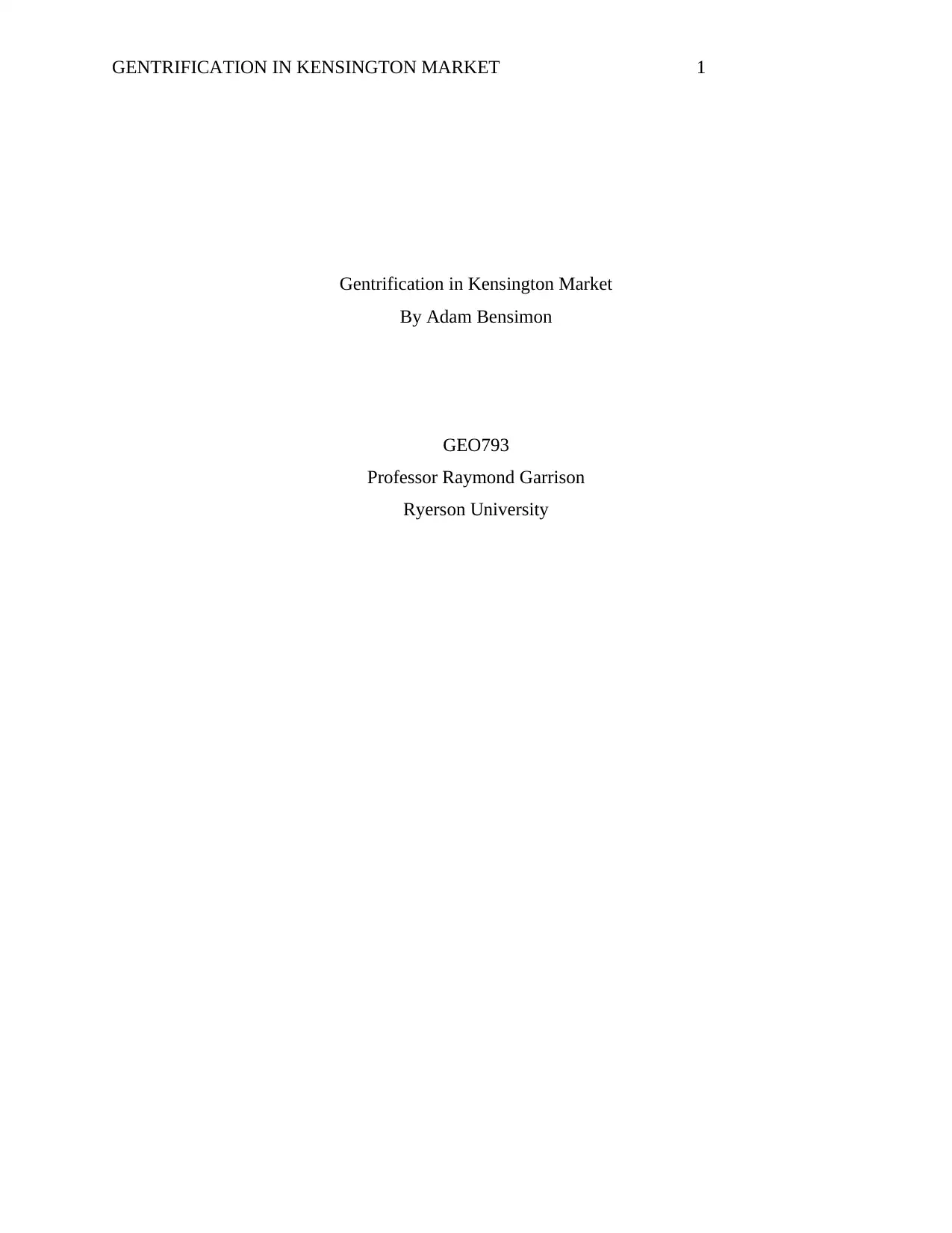
GENTRIFICATION IN KENSINGTON MARKET 1
Gentrification in Kensington Market
By Adam Bensimon
GEO793
Professor Raymond Garrison
Ryerson University
Gentrification in Kensington Market
By Adam Bensimon
GEO793
Professor Raymond Garrison
Ryerson University
Paraphrase This Document
Need a fresh take? Get an instant paraphrase of this document with our AI Paraphraser
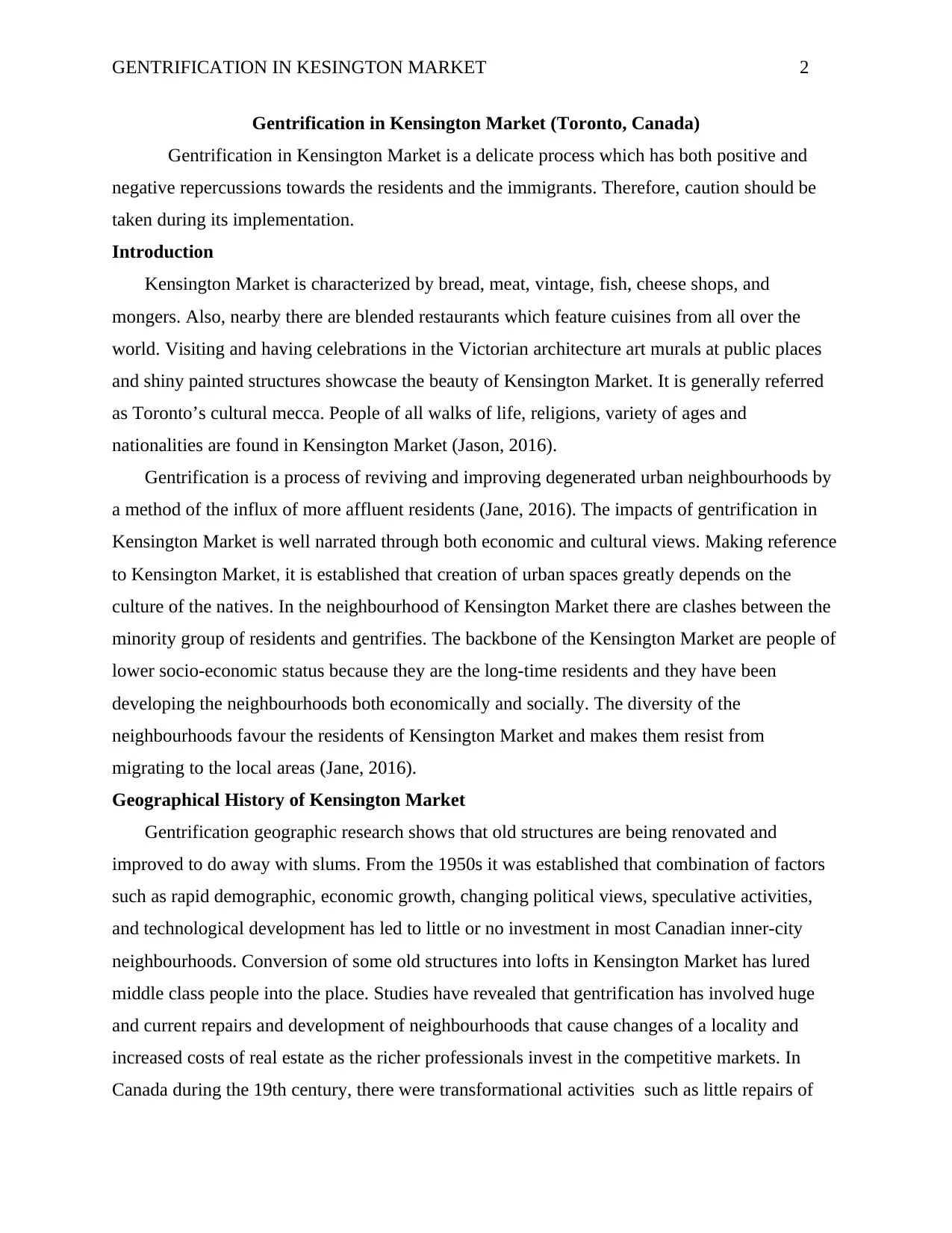
GENTRIFICATION IN KESINGTON MARKET 2
Gentrification in Kensington Market (Toronto, Canada)
Gentrification in Kensington Market is a delicate process which has both positive and
negative repercussions towards the residents and the immigrants. Therefore, caution should be
taken during its implementation.
Introduction
Kensington Market is characterized by bread, meat, vintage, fish, cheese shops, and
mongers. Also, nearby there are blended restaurants which feature cuisines from all over the
world. Visiting and having celebrations in the Victorian architecture art murals at public places
and shiny painted structures showcase the beauty of Kensington Market. It is generally referred
as Toronto’s cultural mecca. People of all walks of life, religions, variety of ages and
nationalities are found in Kensington Market (Jason, 2016).
Gentrification is a process of reviving and improving degenerated urban neighbourhoods by
a method of the influx of more affluent residents (Jane, 2016). The impacts of gentrification in
Kensington Market is well narrated through both economic and cultural views. Making reference
to Kensington Market, it is established that creation of urban spaces greatly depends on the
culture of the natives. In the neighbourhood of Kensington Market there are clashes between the
minority group of residents and gentrifies. The backbone of the Kensington Market are people of
lower socio-economic status because they are the long-time residents and they have been
developing the neighbourhoods both economically and socially. The diversity of the
neighbourhoods favour the residents of Kensington Market and makes them resist from
migrating to the local areas (Jane, 2016).
Geographical History of Kensington Market
Gentrification geographic research shows that old structures are being renovated and
improved to do away with slums. From the 1950s it was established that combination of factors
such as rapid demographic, economic growth, changing political views, speculative activities,
and technological development has led to little or no investment in most Canadian inner-city
neighbourhoods. Conversion of some old structures into lofts in Kensington Market has lured
middle class people into the place. Studies have revealed that gentrification has involved huge
and current repairs and development of neighbourhoods that cause changes of a locality and
increased costs of real estate as the richer professionals invest in the competitive markets. In
Canada during the 19th century, there were transformational activities such as little repairs of
Gentrification in Kensington Market (Toronto, Canada)
Gentrification in Kensington Market is a delicate process which has both positive and
negative repercussions towards the residents and the immigrants. Therefore, caution should be
taken during its implementation.
Introduction
Kensington Market is characterized by bread, meat, vintage, fish, cheese shops, and
mongers. Also, nearby there are blended restaurants which feature cuisines from all over the
world. Visiting and having celebrations in the Victorian architecture art murals at public places
and shiny painted structures showcase the beauty of Kensington Market. It is generally referred
as Toronto’s cultural mecca. People of all walks of life, religions, variety of ages and
nationalities are found in Kensington Market (Jason, 2016).
Gentrification is a process of reviving and improving degenerated urban neighbourhoods by
a method of the influx of more affluent residents (Jane, 2016). The impacts of gentrification in
Kensington Market is well narrated through both economic and cultural views. Making reference
to Kensington Market, it is established that creation of urban spaces greatly depends on the
culture of the natives. In the neighbourhood of Kensington Market there are clashes between the
minority group of residents and gentrifies. The backbone of the Kensington Market are people of
lower socio-economic status because they are the long-time residents and they have been
developing the neighbourhoods both economically and socially. The diversity of the
neighbourhoods favour the residents of Kensington Market and makes them resist from
migrating to the local areas (Jane, 2016).
Geographical History of Kensington Market
Gentrification geographic research shows that old structures are being renovated and
improved to do away with slums. From the 1950s it was established that combination of factors
such as rapid demographic, economic growth, changing political views, speculative activities,
and technological development has led to little or no investment in most Canadian inner-city
neighbourhoods. Conversion of some old structures into lofts in Kensington Market has lured
middle class people into the place. Studies have revealed that gentrification has involved huge
and current repairs and development of neighbourhoods that cause changes of a locality and
increased costs of real estate as the richer professionals invest in the competitive markets. In
Canada during the 19th century, there were transformational activities such as little repairs of
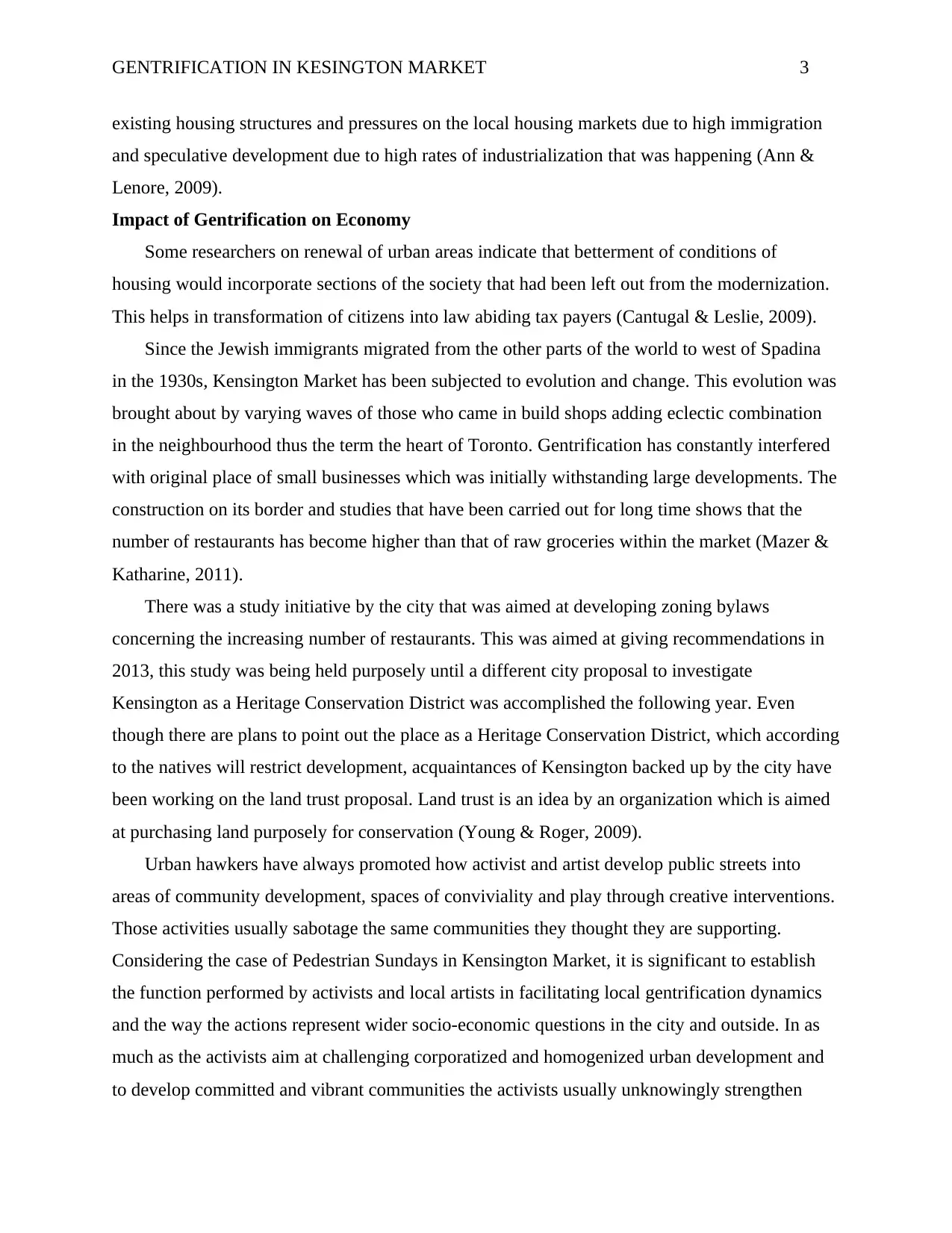
GENTRIFICATION IN KESINGTON MARKET 3
existing housing structures and pressures on the local housing markets due to high immigration
and speculative development due to high rates of industrialization that was happening (Ann &
Lenore, 2009).
Impact of Gentrification on Economy
Some researchers on renewal of urban areas indicate that betterment of conditions of
housing would incorporate sections of the society that had been left out from the modernization.
This helps in transformation of citizens into law abiding tax payers (Cantugal & Leslie, 2009).
Since the Jewish immigrants migrated from the other parts of the world to west of Spadina
in the 1930s, Kensington Market has been subjected to evolution and change. This evolution was
brought about by varying waves of those who came in build shops adding eclectic combination
in the neighbourhood thus the term the heart of Toronto. Gentrification has constantly interfered
with original place of small businesses which was initially withstanding large developments. The
construction on its border and studies that have been carried out for long time shows that the
number of restaurants has become higher than that of raw groceries within the market (Mazer &
Katharine, 2011).
There was a study initiative by the city that was aimed at developing zoning bylaws
concerning the increasing number of restaurants. This was aimed at giving recommendations in
2013, this study was being held purposely until a different city proposal to investigate
Kensington as a Heritage Conservation District was accomplished the following year. Even
though there are plans to point out the place as a Heritage Conservation District, which according
to the natives will restrict development, acquaintances of Kensington backed up by the city have
been working on the land trust proposal. Land trust is an idea by an organization which is aimed
at purchasing land purposely for conservation (Young & Roger, 2009).
Urban hawkers have always promoted how activist and artist develop public streets into
areas of community development, spaces of conviviality and play through creative interventions.
Those activities usually sabotage the same communities they thought they are supporting.
Considering the case of Pedestrian Sundays in Kensington Market, it is significant to establish
the function performed by activists and local artists in facilitating local gentrification dynamics
and the way the actions represent wider socio-economic questions in the city and outside. In as
much as the activists aim at challenging corporatized and homogenized urban development and
to develop committed and vibrant communities the activists usually unknowingly strengthen
existing housing structures and pressures on the local housing markets due to high immigration
and speculative development due to high rates of industrialization that was happening (Ann &
Lenore, 2009).
Impact of Gentrification on Economy
Some researchers on renewal of urban areas indicate that betterment of conditions of
housing would incorporate sections of the society that had been left out from the modernization.
This helps in transformation of citizens into law abiding tax payers (Cantugal & Leslie, 2009).
Since the Jewish immigrants migrated from the other parts of the world to west of Spadina
in the 1930s, Kensington Market has been subjected to evolution and change. This evolution was
brought about by varying waves of those who came in build shops adding eclectic combination
in the neighbourhood thus the term the heart of Toronto. Gentrification has constantly interfered
with original place of small businesses which was initially withstanding large developments. The
construction on its border and studies that have been carried out for long time shows that the
number of restaurants has become higher than that of raw groceries within the market (Mazer &
Katharine, 2011).
There was a study initiative by the city that was aimed at developing zoning bylaws
concerning the increasing number of restaurants. This was aimed at giving recommendations in
2013, this study was being held purposely until a different city proposal to investigate
Kensington as a Heritage Conservation District was accomplished the following year. Even
though there are plans to point out the place as a Heritage Conservation District, which according
to the natives will restrict development, acquaintances of Kensington backed up by the city have
been working on the land trust proposal. Land trust is an idea by an organization which is aimed
at purchasing land purposely for conservation (Young & Roger, 2009).
Urban hawkers have always promoted how activist and artist develop public streets into
areas of community development, spaces of conviviality and play through creative interventions.
Those activities usually sabotage the same communities they thought they are supporting.
Considering the case of Pedestrian Sundays in Kensington Market, it is significant to establish
the function performed by activists and local artists in facilitating local gentrification dynamics
and the way the actions represent wider socio-economic questions in the city and outside. In as
much as the activists aim at challenging corporatized and homogenized urban development and
to develop committed and vibrant communities the activists usually unknowingly strengthen
⊘ This is a preview!⊘
Do you want full access?
Subscribe today to unlock all pages.

Trusted by 1+ million students worldwide
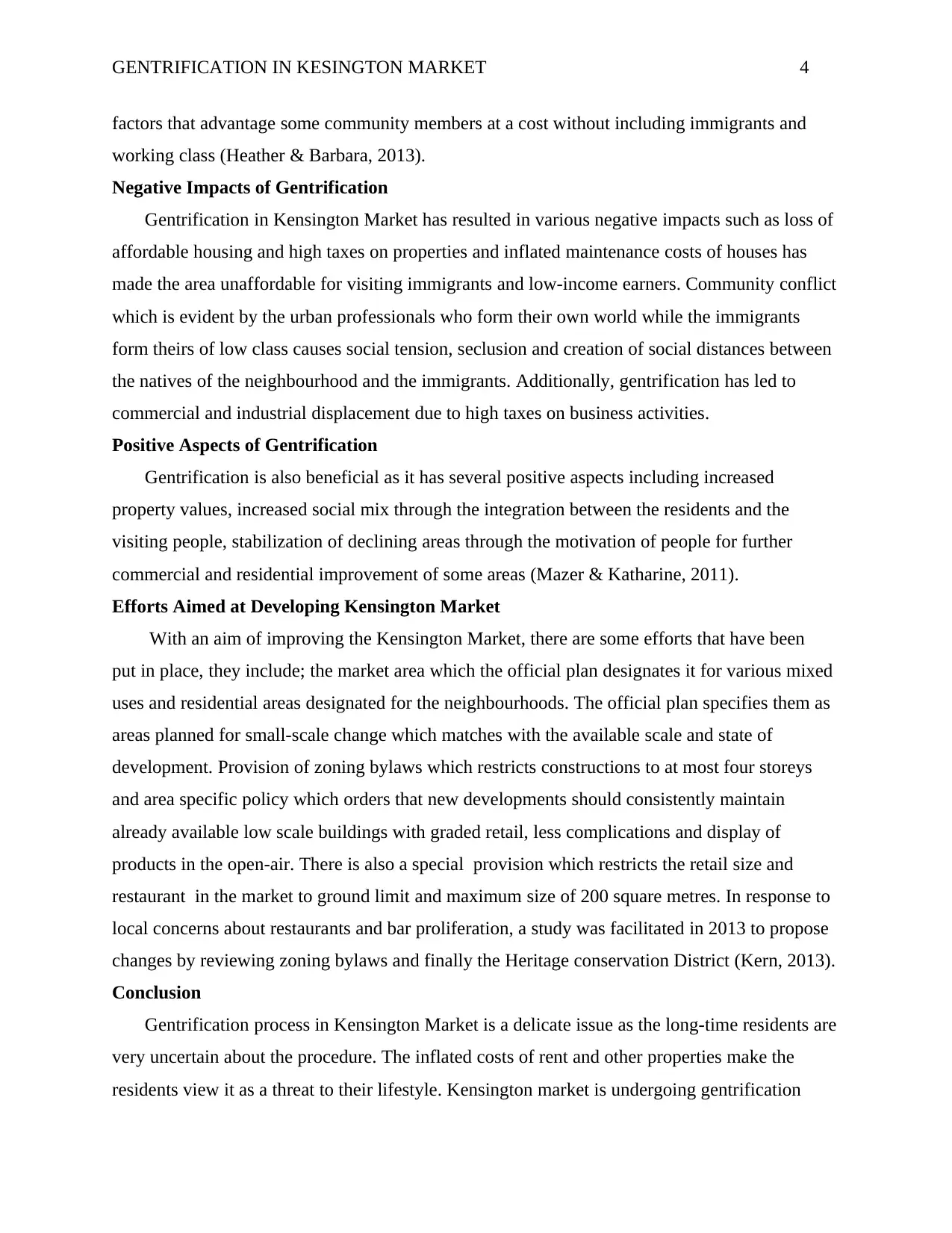
GENTRIFICATION IN KESINGTON MARKET 4
factors that advantage some community members at a cost without including immigrants and
working class (Heather & Barbara, 2013).
Negative Impacts of Gentrification
Gentrification in Kensington Market has resulted in various negative impacts such as loss of
affordable housing and high taxes on properties and inflated maintenance costs of houses has
made the area unaffordable for visiting immigrants and low-income earners. Community conflict
which is evident by the urban professionals who form their own world while the immigrants
form theirs of low class causes social tension, seclusion and creation of social distances between
the natives of the neighbourhood and the immigrants. Additionally, gentrification has led to
commercial and industrial displacement due to high taxes on business activities.
Positive Aspects of Gentrification
Gentrification is also beneficial as it has several positive aspects including increased
property values, increased social mix through the integration between the residents and the
visiting people, stabilization of declining areas through the motivation of people for further
commercial and residential improvement of some areas (Mazer & Katharine, 2011).
Efforts Aimed at Developing Kensington Market
With an aim of improving the Kensington Market, there are some efforts that have been
put in place, they include; the market area which the official plan designates it for various mixed
uses and residential areas designated for the neighbourhoods. The official plan specifies them as
areas planned for small-scale change which matches with the available scale and state of
development. Provision of zoning bylaws which restricts constructions to at most four storeys
and area specific policy which orders that new developments should consistently maintain
already available low scale buildings with graded retail, less complications and display of
products in the open-air. There is also a special provision which restricts the retail size and
restaurant in the market to ground limit and maximum size of 200 square metres. In response to
local concerns about restaurants and bar proliferation, a study was facilitated in 2013 to propose
changes by reviewing zoning bylaws and finally the Heritage conservation District (Kern, 2013).
Conclusion
Gentrification process in Kensington Market is a delicate issue as the long-time residents are
very uncertain about the procedure. The inflated costs of rent and other properties make the
residents view it as a threat to their lifestyle. Kensington market is undergoing gentrification
factors that advantage some community members at a cost without including immigrants and
working class (Heather & Barbara, 2013).
Negative Impacts of Gentrification
Gentrification in Kensington Market has resulted in various negative impacts such as loss of
affordable housing and high taxes on properties and inflated maintenance costs of houses has
made the area unaffordable for visiting immigrants and low-income earners. Community conflict
which is evident by the urban professionals who form their own world while the immigrants
form theirs of low class causes social tension, seclusion and creation of social distances between
the natives of the neighbourhood and the immigrants. Additionally, gentrification has led to
commercial and industrial displacement due to high taxes on business activities.
Positive Aspects of Gentrification
Gentrification is also beneficial as it has several positive aspects including increased
property values, increased social mix through the integration between the residents and the
visiting people, stabilization of declining areas through the motivation of people for further
commercial and residential improvement of some areas (Mazer & Katharine, 2011).
Efforts Aimed at Developing Kensington Market
With an aim of improving the Kensington Market, there are some efforts that have been
put in place, they include; the market area which the official plan designates it for various mixed
uses and residential areas designated for the neighbourhoods. The official plan specifies them as
areas planned for small-scale change which matches with the available scale and state of
development. Provision of zoning bylaws which restricts constructions to at most four storeys
and area specific policy which orders that new developments should consistently maintain
already available low scale buildings with graded retail, less complications and display of
products in the open-air. There is also a special provision which restricts the retail size and
restaurant in the market to ground limit and maximum size of 200 square metres. In response to
local concerns about restaurants and bar proliferation, a study was facilitated in 2013 to propose
changes by reviewing zoning bylaws and finally the Heritage conservation District (Kern, 2013).
Conclusion
Gentrification process in Kensington Market is a delicate issue as the long-time residents are
very uncertain about the procedure. The inflated costs of rent and other properties make the
residents view it as a threat to their lifestyle. Kensington market is undergoing gentrification
Paraphrase This Document
Need a fresh take? Get an instant paraphrase of this document with our AI Paraphraser
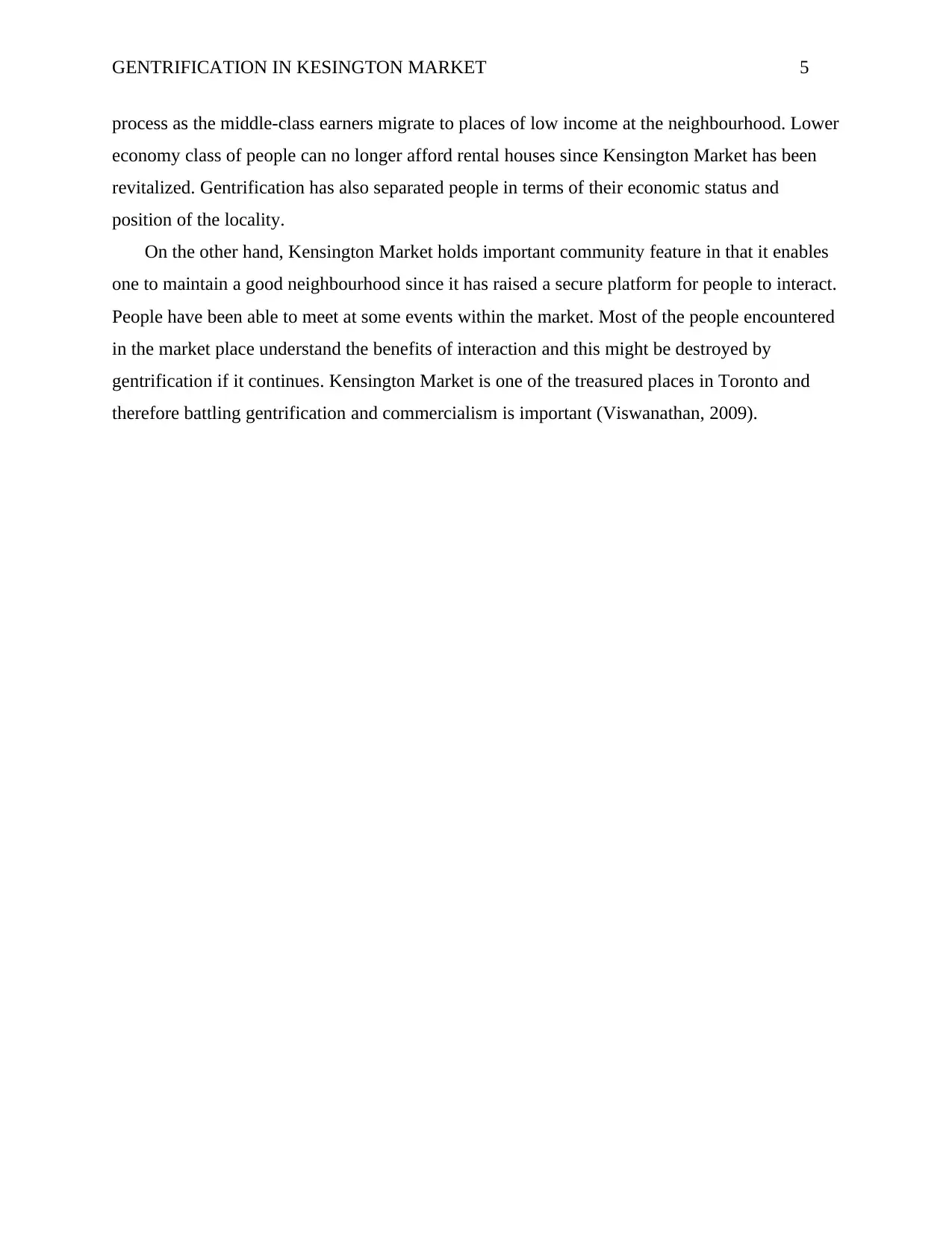
GENTRIFICATION IN KESINGTON MARKET 5
process as the middle-class earners migrate to places of low income at the neighbourhood. Lower
economy class of people can no longer afford rental houses since Kensington Market has been
revitalized. Gentrification has also separated people in terms of their economic status and
position of the locality.
On the other hand, Kensington Market holds important community feature in that it enables
one to maintain a good neighbourhood since it has raised a secure platform for people to interact.
People have been able to meet at some events within the market. Most of the people encountered
in the market place understand the benefits of interaction and this might be destroyed by
gentrification if it continues. Kensington Market is one of the treasured places in Toronto and
therefore battling gentrification and commercialism is important (Viswanathan, 2009).
process as the middle-class earners migrate to places of low income at the neighbourhood. Lower
economy class of people can no longer afford rental houses since Kensington Market has been
revitalized. Gentrification has also separated people in terms of their economic status and
position of the locality.
On the other hand, Kensington Market holds important community feature in that it enables
one to maintain a good neighbourhood since it has raised a secure platform for people to interact.
People have been able to meet at some events within the market. Most of the people encountered
in the market place understand the benefits of interaction and this might be destroyed by
gentrification if it continues. Kensington Market is one of the treasured places in Toronto and
therefore battling gentrification and commercialism is important (Viswanathan, 2009).
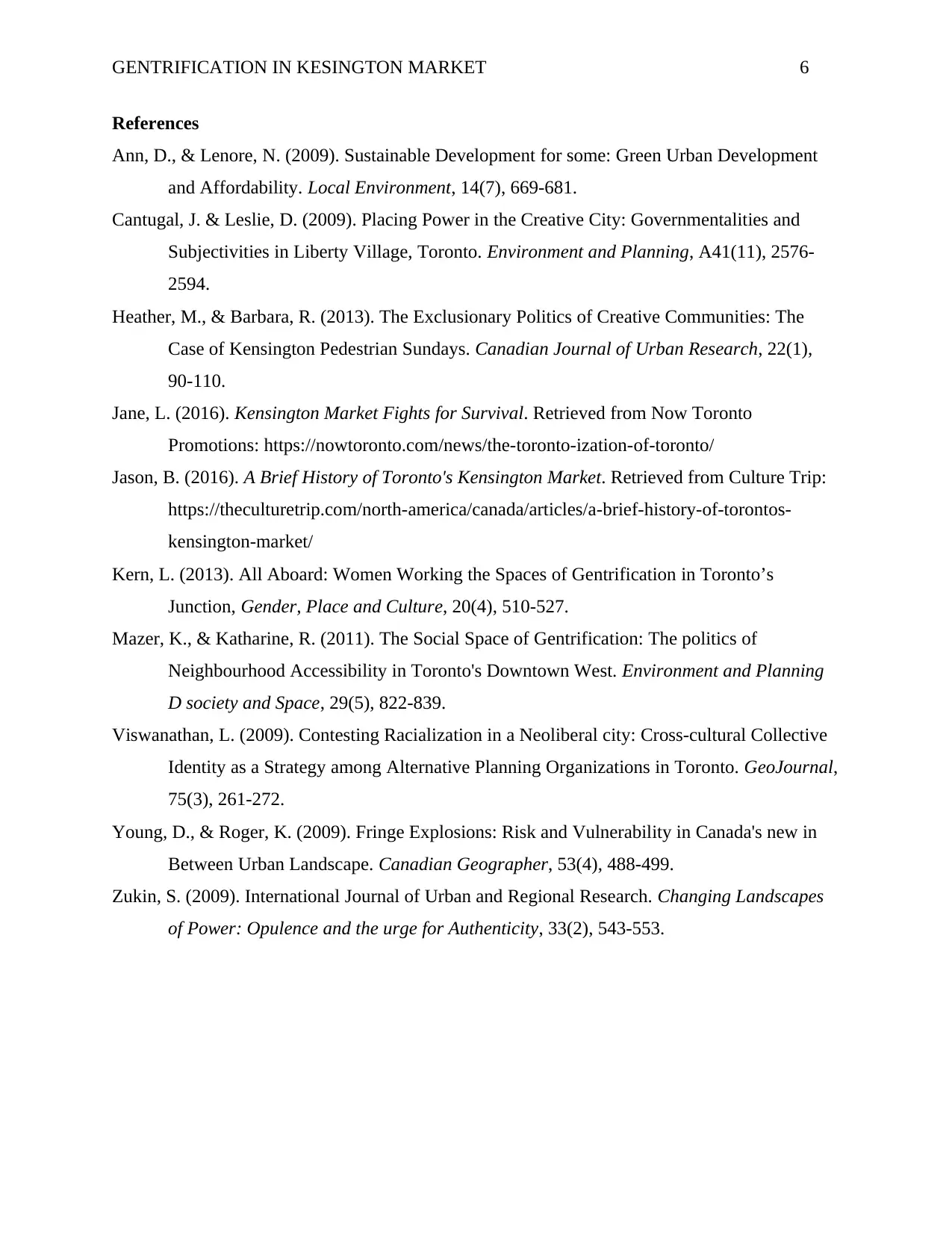
GENTRIFICATION IN KESINGTON MARKET 6
References
Ann, D., & Lenore, N. (2009). Sustainable Development for some: Green Urban Development
and Affordability. Local Environment, 14(7), 669-681.
Cantugal, J. & Leslie, D. (2009). Placing Power in the Creative City: Governmentalities and
Subjectivities in Liberty Village, Toronto. Environment and Planning, A41(11), 2576-
2594.
Heather, M., & Barbara, R. (2013). The Exclusionary Politics of Creative Communities: The
Case of Kensington Pedestrian Sundays. Canadian Journal of Urban Research, 22(1),
90-110.
Jane, L. (2016). Kensington Market Fights for Survival. Retrieved from Now Toronto
Promotions: https://nowtoronto.com/news/the-toronto-ization-of-toronto/
Jason, B. (2016). A Brief History of Toronto's Kensington Market. Retrieved from Culture Trip:
https://theculturetrip.com/north-america/canada/articles/a-brief-history-of-torontos-
kensington-market/
Kern, L. (2013). All Aboard: Women Working the Spaces of Gentrification in Toronto’s
Junction, Gender, Place and Culture, 20(4), 510-527.
Mazer, K., & Katharine, R. (2011). The Social Space of Gentrification: The politics of
Neighbourhood Accessibility in Toronto's Downtown West. Environment and Planning
D society and Space, 29(5), 822-839.
Viswanathan, L. (2009). Contesting Racialization in a Neoliberal city: Cross-cultural Collective
Identity as a Strategy among Alternative Planning Organizations in Toronto. GeoJournal,
75(3), 261-272.
Young, D., & Roger, K. (2009). Fringe Explosions: Risk and Vulnerability in Canada's new in
Between Urban Landscape. Canadian Geographer, 53(4), 488-499.
Zukin, S. (2009). International Journal of Urban and Regional Research. Changing Landscapes
of Power: Opulence and the urge for Authenticity, 33(2), 543-553.
References
Ann, D., & Lenore, N. (2009). Sustainable Development for some: Green Urban Development
and Affordability. Local Environment, 14(7), 669-681.
Cantugal, J. & Leslie, D. (2009). Placing Power in the Creative City: Governmentalities and
Subjectivities in Liberty Village, Toronto. Environment and Planning, A41(11), 2576-
2594.
Heather, M., & Barbara, R. (2013). The Exclusionary Politics of Creative Communities: The
Case of Kensington Pedestrian Sundays. Canadian Journal of Urban Research, 22(1),
90-110.
Jane, L. (2016). Kensington Market Fights for Survival. Retrieved from Now Toronto
Promotions: https://nowtoronto.com/news/the-toronto-ization-of-toronto/
Jason, B. (2016). A Brief History of Toronto's Kensington Market. Retrieved from Culture Trip:
https://theculturetrip.com/north-america/canada/articles/a-brief-history-of-torontos-
kensington-market/
Kern, L. (2013). All Aboard: Women Working the Spaces of Gentrification in Toronto’s
Junction, Gender, Place and Culture, 20(4), 510-527.
Mazer, K., & Katharine, R. (2011). The Social Space of Gentrification: The politics of
Neighbourhood Accessibility in Toronto's Downtown West. Environment and Planning
D society and Space, 29(5), 822-839.
Viswanathan, L. (2009). Contesting Racialization in a Neoliberal city: Cross-cultural Collective
Identity as a Strategy among Alternative Planning Organizations in Toronto. GeoJournal,
75(3), 261-272.
Young, D., & Roger, K. (2009). Fringe Explosions: Risk and Vulnerability in Canada's new in
Between Urban Landscape. Canadian Geographer, 53(4), 488-499.
Zukin, S. (2009). International Journal of Urban and Regional Research. Changing Landscapes
of Power: Opulence and the urge for Authenticity, 33(2), 543-553.
⊘ This is a preview!⊘
Do you want full access?
Subscribe today to unlock all pages.

Trusted by 1+ million students worldwide
1 out of 6
Your All-in-One AI-Powered Toolkit for Academic Success.
+13062052269
info@desklib.com
Available 24*7 on WhatsApp / Email
![[object Object]](/_next/static/media/star-bottom.7253800d.svg)
Unlock your academic potential
Copyright © 2020–2025 A2Z Services. All Rights Reserved. Developed and managed by ZUCOL.

